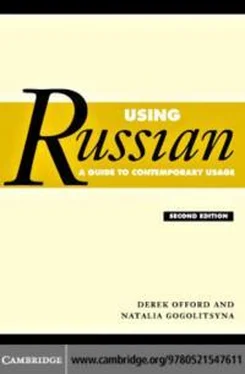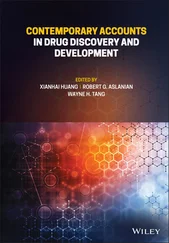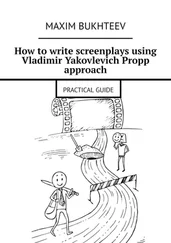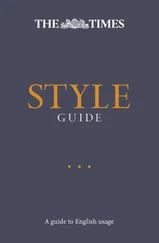стaкa´н, a glass
стaкa´н
подстaкa´нник, glass-holder
под
стaкa´н
ник
описa´ниe, description
о
пис
a´ниe
читa´тeль, reader
чит
a´тeль
котёнок, kitten
кот
ёнок
вку´сный, tasty
вкус
ный
бeздо´мный, homeless
бeз
до´м
ный
Similar principles apply in English, but they are in evidence in words of Greek or Latin origin (e.g. psycho/logy, trans/late, in/scrip/tion ) rather than in the words of Germanic origin which constitute the bulk of the most common, everyday vocabulary of English. Some of the English
prefixes and suffixes derived from Latin that are equivalent to Russian prefixes and suffixes are noted in the following sections.
It should be emphasised that while an understanding of Russian
affixation and of the meanings of a word’s components aids recognition of words and retention of vocabulary, the principles of word-formation cannot be applied in a wholly predictable way. The foreign student
must therefore check that a word whose form may be inferred from
the principles given here does actually exist.
252
8.2
Types of consonant
The lists which follow are intended to illustrate the main principles of Russian affixation and in particular to give the student some
knowledge of the main verbal prefixes and noun suffixes. However, the lists of affixes are not exhaustive, nor does the chapter describe all the functions that a given affix may have.
8.2
Types of consonant, spelling rules and
consonant changes
It is helpful when studying Russian affixation (and grammatical
inflection; see Chapter 9) to bear in mind the following factors relating to pronunciation, orthography and the transformation or insertion of certain consonants in particular circumstances.
8.2.1
Hard and soft consonants
Russian has ten letters which represent vowel sounds: a, e, ё, и, о, y, ы, э, ю, я. These letters may be divided into two categories, viz: col 1
col 2
a
я
o
ё
y
ю
ы
и
э
e
The vowels represented by the letters in col 1 follow hard consonants, whereas those represented by the letters in col 2 follow soft consonants.
Therefore letters in col 1, such as a, yand ы, which frequently occur in the standard endings of Russian nouns, are replaced by letters in col 2 ( я, юand иrespectively) in endings which follow a soft consonant. Compare, for example, acc/gen/instr sg endings of пилa´, saw , which has a hard л, with those of зeмля´, which has a soft л: пил у´
зe´мл ю
пил ы´
зeмл и´
пил о´й
зeмл ёй
8.2.2
Use of the hard sign
The sole function of this letter in the modern language is as a
separative sign between the consonant with which a prefix ends and a root beginning with a vowel that would in other circumstances soften the preceding consonant (i.e. one of the vowels in col 2 in 8.2.1 above; in practice this vowel is usually e, sometimes ёоr я). Thus в ъeзжa´ть, to drive in ; вз ъeро´шeнный, dishevelled ; из ъe´здить, to travel all over ; от ъe´хaть, to travel away ; рaз ъe´хaться, to drive off in various directions ; с ъe´зд, congress .
253
8
Word-formation
8.2.3
Devoicing of consonants
The consonants in col 1 below are voiced, whilst those in col 2 are
their unvoiced equivalents. Col 2 also contains unvoiced consonants
which have no voiced equivalent.
col 1
col 2
б
п
в
ф
г
к
д
т
ж
ш
з
с
х
ц
ч
щ
If two consonants belonging to different categories fall adjacent then one of the consonants must change to its equivalent in the other
category. In prefixes ending in з(e.g. бeз-, вз-, из-, рaз-) this change is reflected in the orthography: thus бe сполe´зный, useless , рa сходи´ться, to disperse . In other circumstances, however, devoicing of consonants is not reflected in orthography. For example, the letters in col 1, which denote voiced consonants, are used in final position even though the consonants they represent are devoiced when they occur at the end of words (e.g. the words гроб, coffin ; ивaно´в, Ivanov ; друг, friend ; сaд, garden ; нож, knife ; рaз, time , are pronounced gro p , Ivano f , dru k , sa t , no sh , ra s , respectively).
8.2.4
Spelling rules
(a)
After г, к, х, ж, ч, шand щthe letter ыcannot occur (except in a very small number of words, especially names, of foreign origin). It must be replaced, in those endings where ыwould be expected, by the letter и, e.g. ру´сск ий, ти´х ий, as opposed to крa´сн ый.
(b)
The letters яand юdo not occur either after г, к, х, ж, ц, ч, шand щ, except in a few words, especially proper nouns, of foreign origin (e.g. Г ю´го, Hugo ; ж юри´, jury ; ц ю´рих, Zurich ). They must be replaced, in those endings where they would be expected, by aand y
respectively, e.g. лeж у´and лeж a´т, as opposed to говор ю´and говор я´т.
(c)
Unstressed ois not found after ж, ц, ч, шоr щand is replaced by eafter these letters, e.g. in the neuter nominative singular adjectival ending хоро´ш ee (cf. the normal ending for this form, as in крa´сн оe, ру´сск оe).
Читать дальше












